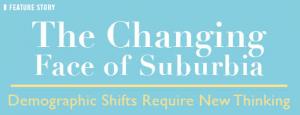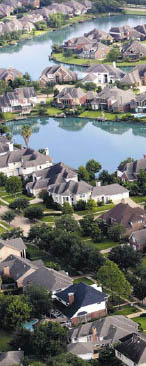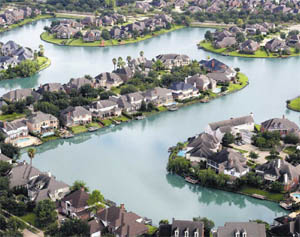
In the past 15 to 20 years, the basic character of the suburbs has been changing rapidly, and racial, ethnic and economic diversity is becoming more and more the norm in communities outside America’s central cities.
“Suburbia is undergoing some of the most dynamic demographic change anywhere,” says Lawrence Levy, executive director of Hofstra University’s National Center for Suburban Studies in Hempstead, New York. “It’s what makes it interesting to study. It’s what makes it challenging to govern.”
 “The suburbs are just new forms of cities,” notes Robert Lang, director of the Metropolitan Institute at Virginia Tech and co-author of Boomburbs: The Rise of America’s Accidental Cities (2007). “They’re not suburbs the way most people think of them. When you’re half the U.S. [population] and the U.S. is diverse, how can you not have cultural diversity? There’s poverty and wealth. There’s good and bad. Anything that’s in America is in the suburbs. Some of them have more diversity than the central cities themselves.”
“The suburbs are just new forms of cities,” notes Robert Lang, director of the Metropolitan Institute at Virginia Tech and co-author of Boomburbs: The Rise of America’s Accidental Cities (2007). “They’re not suburbs the way most people think of them. When you’re half the U.S. [population] and the U.S. is diverse, how can you not have cultural diversity? There’s poverty and wealth. There’s good and bad. Anything that’s in America is in the suburbs. Some of them have more diversity than the central cities themselves.”
Lang points out that in Orange County, California – once the epitome of white, suburban monoculture – half of the population is minority and Fairfax County, Va., is now more diverse than the District of Columbia, its central city. He says similar examples can be cited from all across the country.
“The suburbs are interesting places,” he says. “You go one direction out of the city and the issue is tear-downs – people demolishing 1950s homes and erecting giant houses. Three suburbs over, and another direction out of the city, the issue is abandonment.”
Much of this change is due to the huge wave of immigration that bookended the 20th century and continues into the 21st. The early 1900s brought millions of new arrivals to this country, mostly working-class Europeans. In those days, immigration meant passing through Ellis Island and settling in a tenement in an ethnic enclave in Brooklyn on New York’s Lower East Side. Although the immigration spigot was shut off in the mid-1920s, many of the descendents of those early 20th century newcomers had migrated to the suburbs by the middle of the century.
The landmark Immigration Act of 1965 reopened the floodgates. According to an analysis of census data compiled last November by the Center for Immigration Studies in Washington, immigration from 2000 to 2007 was the highest for any seven-year period in American history, bringing 10.3 million new arrivals. The study found that one in eight people living in the U.S. is an immigrant, adding up to a total of 37.9 million people – the highest number since 1930.
Unlike their predecessors, not all immigrants today settle in cities. According to an annual survey by the Census Bureau in 2007, about four in 10 immigrants move directly to the nation’s suburbs, bypassing the urban enclaves of central cities altogether. Coupled with the high rate of immigration, the result is greatly increasing diversity in suburbia.
“Minority groups and immigrant groups, as they come up the socio-economic ladder, want the same things my parents did when they moved from New York City out to Long Island,” says Levy. “They want a house. They want good schools for their kids. And they think they can find it in the suburbs more so than in the cities. As they have the ability to get mortgages and to buy houses, they’re coming out to the suburban areas directly, without first living in cities. And as minority groups and as immigrant groups come to the suburbs, they’re changing its face – literally and figuratively.”
This demographic change is affecting communities all across the country. Hispanic and Asian Americans are the fastest growing population blocks in the suburbs, and African-Americans are moving to suburbia in increasing numbers. According to the Census Bureau, non-whites make up a majority in nearly one in three of the most populous counties in the country and in almost one in 10 of all 3,100 counties. Since 2000, the number of legal and illegal immigrants living in suburbs has surpassed the number in cities, 52 percent to 48 percent. Today, more than one quarter of all suburbanites is a racial or ethnic minority.
 “All the major ethnic groups are suburbanizing,” William H. Frey, a demographer with the Brookings Institution, told the New York Times last fall. “What drives it is where the jobs and cheap housing are.”
“All the major ethnic groups are suburbanizing,” William H. Frey, a demographer with the Brookings Institution, told the New York Times last fall. “What drives it is where the jobs and cheap housing are.”
“Ultimately the new arrivals to the suburbs are going to be a big net benefit,” says Levy. “They will bring new blood. They’ll bring new vision and new energy. They’ll run for office. They will want to revive the schools because this is now their home. They will want to solve the transportation problems because they’ll want to get from here to there. Ultimately, it’s a good thing.”
As the suburbs have become more like America, they reflect other demographic trends. Ozzie and Harriet and the Bradys may have lived in a suburbia inhabited primarily by traditional, nuclear families, but the 2000 census revealed that the suburbs now contain more non-family households (mostly young singles and elderly people living alone) than married couples with children.
New Challenges
The new suburban demographic has brought with it new challenges, and the suburbs are dealing with problems in housing, crime, social services, education, racial and ethnic conflict, transportation, air quality and the like. Big-city problems have migrated to the suburbs.
“The problem is, most suburbs aren’t ready,” says Peter Dreier, director of the Urban and Environmental Policy Program at Occidental College in Los Angeles. “A lot of the suburbs don’t have the social infrastructure to address homelessness or poverty or issues like that.”
Some suburbs are more welcoming of immigrants than others. In the neighboring towns of Edison and Iselin in northern New Jersey, immigrants from India have revitalized a blighted business strip – though not without creating friction among the native-born residents. In part of Long Island, tensions between long-time residents and new immigrants, many of them illegal workers, are reaching a flash point.
Housing is also a problem in many communities. There’s not a lot of low-income housing in the suburbs, so ironically the poor people in the suburbs are more likely to be living in over-crowded housing. Without affordable housing, many suburbs have difficulties attracting and retaining workers in local businesses and industries. Hospitals in affluent suburbs, for instance, often experience high rates of turnover among their nursing staffs, as employees cannot afford to live in the community and leave for jobs closer to home as soon as the opportunity presents itself.
Some communities, like Lake Forest, Illinois, one of Chicago’s most expensive and idyllic suburbs, are dealing with the problem by passing new ordinances requiring developers of large projects to include some affordable housing in the mix.
Even traffic congestion, a perennial suburban challenge, is taking on a new complexion as people are more and more often commuting from one suburb to another, rather than from the suburbs to the city. The carrying capacity of existing roads and highways are strained, and traffic has gotten worse in many suburbs.
“The real question is, how do we deal with these issues politically?” asks Dreier. “We have widening inequality in the country, so we have widening inequality in the suburbs. How do we deal with issues like spreading poverty? How do you build a political constituency to deal with these issues? It’s no longer the cities versus the suburbs. Now it’s the older suburbs and the central cities that need to form coalitions to address these issues.”
For all the problems facing the suburbs, Lawrence Levy is optimistic.
“There are going to be some rough patches of adjustment,” he says. “School districts are going to have to learn how to educate kids who speak different languages and come from different cultures. The governments are going to have to make sure that they provide the same level of quality of services they did when the neighborhood was white. Most of the people moving in are not just poor people without any sophistication. These are folks who run businesses. These are folks who are college educated and they are going to demand high quality services. Ultimately, the diversity should become a strength.”
